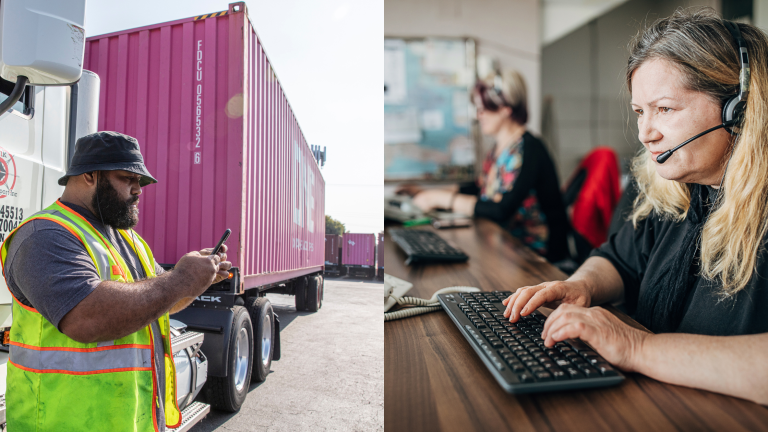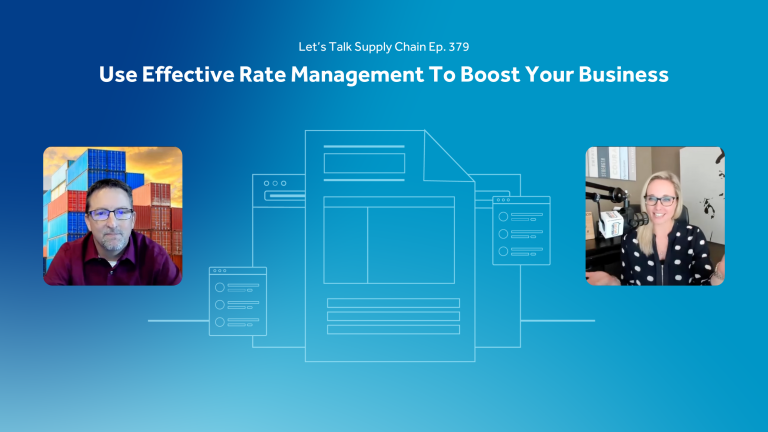What Does TMS Stand For?
Transportation management system/software (TMS) is a system of management for supply chains to aid in the movement of goods. It is also a helpful tool for boosting business and growing the company.
Broken down, this basically means it’s an aid for truck drivers to move supplies for companies from point A (usually a warehouse) to point B (usually a store). Generally, this software can be uploaded to any company’s interface to provide important details to the company and the driver. This information can range from changes in deliver time or place to a complete reroute from the original drop off point to a new location. TMS software ensures the drivers know what they are supposed to do, while alerting them of any changes made last minute by the company.
What It Means
The TMS system works throughout multiple companies at one time to ensure each person involved has the information required to do their job correctly and move freight for any company where it needs to go.
Depending on the type of system the company uses, it’s possible to have advanced features for reports or integrations when one driver is working with multiple companies. It means the company (or companies) and the driver can communicate with each other at all times to ensure the freight in question leaves from and arrives at the correct locations.
Types of TMS
There are a few different types of TMS that could be useful to a company or driver. Each type has its pros and cons that could make it right or wrong for the specific needs of the individual or group.
The earliest use of TMS was on-premise software. This worked if the company had a computer available with internet to upload information and allow other companies with computers and internet to work with any information uploaded by each other. While this system helped the companies out, things were still difficult for the drivers who were not guaranteed to have computers or internet in their trucks.
As time went on, the realization that on-premise technology was not helpful for the driver came into play and created the cloud-based/SaaS (software-as-a-service) version of TMS. In today’s world, most drivers have a smartphone. This allows them to access information on the cloud from anywhere at any time. The driver can see a new run or changes made to a previously scheduled run. The cloud-based TMS also provides easier access for updates and installation for the system.
Due to the ease of access with a TMS, the companies can easily track, book, and rate their drivers, and each driver can see this information as well. Think of it as an easier way for the company to tell the driver he or she did a great job, or that they need to take freight from one location to another.
How Does a TMS Work?
TMS focuses on the most reliable, efficient, and cost-effective ways to deliver freight. This system can track any packages or larger freight from the location it departs, to every stop it makes, until it reaches its destination.
More companies are implementing TMS every day to provide better service all around. This process of using TMS provides more perks than tracking freight. Because companies can track their freight and packages, they are providing better customer service to their consumers. Any customers working with these companies can track their packages and pinpoint their arrival. This allows customers to have more say in their shopping and provides companies with repeat business.
What a TMS Does
The idea is that TMS provides information to and from drivers and companies to keep everyone, including customers, in the loop of where the freight is and how or when it might arrive at its destination.
The better side of this idea provides important delivery, inventory, and cash flow aspects to businesses and drivers. Having a TMS can provide the business with a detailed set of information for delivery options and information, as well as providing the driver with a bill of landing that can be immediately seen by the company should they choose.
Another way TMS works well with companies and their drivers is by lowering their inventory requirements. Because the company can see the customer is receiving their deliveries, this cuts back on their inventory and provides the opportunity to better predict their future inventory.
All of these options also provide improvements to the company’s cash flow. TMS provides accounting for freights within the system, allowing drivers and companies to account for payments, audit their inventory and books, and provide consolidation for products on hand or leaving with a driver.
How a TMS Helps
While above addresses the ideas of tracking deliveries, increasing customer relations, and improving inventory; there is still more to be said about the benefits of TMS. It’s a system with many faces that can help grow any business to reach its full potential.
This system provides the opportunity for a company’s warehouse to improve its efficiency and for the company to increase its supply chain. The improvements at the warehouse come from the ability to track and record orders within the system. This allows for the efficiency and productivity at the warehouse to boost, not only the warehouse work, but the customer satisfaction rates. By having an efficient warehouse team, the freight can be sent out quicker and thereby be delivered to the customer in a timely manner.
The improvements to the supply chain are made based on many factors. Some of these are on the driver more than the company. Having the ability to track the driver and the package provides an ease of proficiency in knowing when the driver picks up or delivers the package and having the sense of comfort that the package was delivered to the correct location. This provides an easier supply chain from the company to the customer.
Benefits of a TMS
Many benefits have already been discussed in the previous sections. The idea at this point is to bring together the many benefits and discuss the options of those still left out of the list. So far, the discussion has encompassed deliveries, cost, customer service, warehouse production, supply, and company cash flow.
All of these ideas produce great results with TMS and aid in overall business satisfaction. It’s important to note that TMS is not responsible for companies and drivers achieving these goals. TMS can only aid in the ease of these topics, the program helps a company get organized and be able to do all these things through the program, but it doesn’t do them for the company. Someone at the company, or a driver, still has to push buttons to make things happen.
Another perk of TMS software is the ability to tell which carriers to continue working with. The software can tell how frequently a carrier delivers a package to a customer on time. If a company has been working with a carrier that’s always late, it will make them want to find a new carrier to boost warehouse numbers and customer satisfaction rating. This software can help determine which carriers are the best.
Once the software is up and running, it’s easy to tell which carriers show up on time and which don’t. Making that distinction can mean the difference between a repeat customer and an angry one. It’s important that customers receive their packages on time, especially if they are able to track them and know when they should arrive.
The Specialized Software
TMS (Transportation Management System/Software) is a specialized software to aid in the growing business world. It can provide a multitude of advancements in any company if given the chance to work. With this software any company could boost sales, warehouse production, customer satisfaction rates, deliveries, and even cash flow.
The most important thing to remember about TMS is that the company has to do the work. This isn’t a system to just plug in and let do the work for you. It’s going to be a learning curve and, for some, an adjustment, but it will all be worth it in the end when all the changes are positive and moving forward.
Be sure to do the research before purchasing a system. Each one is different, and some will not have a single aspect needed while others will have too many that aren’t needed for the company. It’s important to choose the right program for the business needs, otherwise it’s a pure waste of time and money.
While all of this sounds great, it’s still important to choose the right system. This site has a list of all TMS providers to ensure the company has what they need. It is important to research every system before making a decision to ensure the company has everything it will need to succeed.
Don’t let the list be a trickster. Being at the top of the list, in this case, doesn’t make that software the best choice. It’s still important to consider each one on an individual basis and decide which features will work best for what the company needs. It’s also important to decide which one works, not only for the company’s needs, but can work for the drivers as well. Be sure all employees, drivers included, are able to easily use the software. This will be a safe point to show that each individual can use this program for the company to get the information and results it needs to move forward.
It wouldn’t be right to find a software that fits the company, but it doesn’t work for the driver out on the road. The importance of the driver’s needs is equal to that of the company’s needs. If the driver can’t use the software, there’s no chance the company can keep track of them. Part of the benefits of TMS is to ensure customer satisfaction and on-time deliveries.
It wouldn’t be possible to follow through with the latter if the software the company chose didn’t allow the driver to access the information to be able to inform the company when the package was delivered. Choosing the right software can help to avoid this mess and provide peace of mind and ease of use for all involved. This software could provide the company with the information it needs to prove suspicions that perhaps the carrier isn’t as efficient as they’ve been seeming to be.
Conclusion
Many will buy the first one on the list because it’s first. The problem is, first doesn’t always mean better and that may not be what the company needs at all. It’s important to know the difference and understand what is needed to make the company thrive before choosing a software to make that happen. Ensuring the company is using the correct software is always step one. Without this step, the others are impossible and it would seem pointless to try moving forward.
Always be sure to purchase the software that’s best for the company and the driver. It’s also important to use the software as designed to ensure maximum performance. The more the company uses it, the better their chances are of growing business and having higher customer satisfaction rates. It’s always important to ensure maximum planning and software usage to keep the business growing in the right direction.
It’s time to make the choice. Is TMS right for the company? If so, which system will be best to make the business grow? Keep in mind that all TMS systems are not the same and what some programs lack, others have and those make it easy. Be sure to do the research and find a TMS that’s best for the company, the driver, and (by extension) the customer, or it could just mean the difference between growing the business or ending it; and no one wants to see that happen.




